Input interpretation

iodine (chemical element) | niobium (chemical element) | antimony (chemical element)
Periodic table location
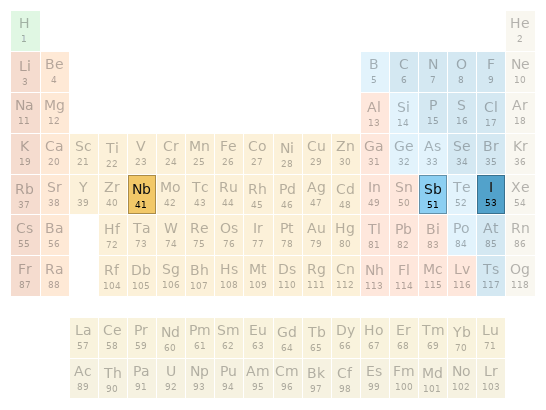
Periodic table location
Images
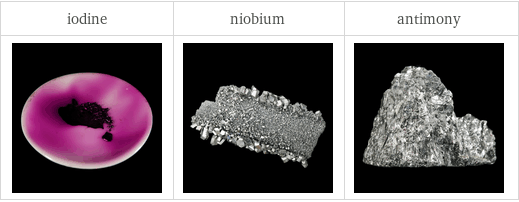
Images
Basic elemental properties
![| iodine | niobium | antimony atomic symbol | I | Nb | Sb atomic number | 53 | 41 | 51 short electronic configuration | [Kr]5s^24d^105p^5 | [Kr]5s^14d^4 | [Kr]5s^24d^105p^3 Aufbau diagram | 5p 4d 5s | 4d 5s | 5p 4d 5s block | p | d | p group | 17 | 5 | 15 period | 5 | 5 | 5 atomic mass | 126.90447 u | 92.90637 u | 121.76 u half-life | (stable) | (stable) | (stable)](../image_source/ebe90a5574677f4ca88b05efb2c885f6.png)
| iodine | niobium | antimony atomic symbol | I | Nb | Sb atomic number | 53 | 41 | 51 short electronic configuration | [Kr]5s^24d^105p^5 | [Kr]5s^14d^4 | [Kr]5s^24d^105p^3 Aufbau diagram | 5p 4d 5s | 4d 5s | 5p 4d 5s block | p | d | p group | 17 | 5 | 15 period | 5 | 5 | 5 atomic mass | 126.90447 u | 92.90637 u | 121.76 u half-life | (stable) | (stable) | (stable)
Thermodynamic properties
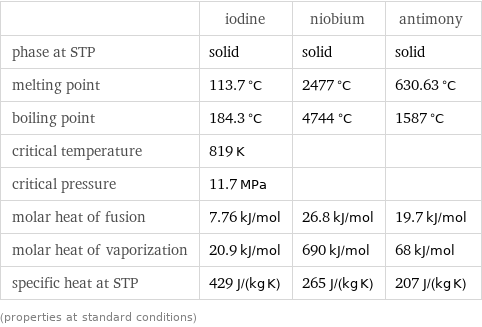
| iodine | niobium | antimony phase at STP | solid | solid | solid melting point | 113.7 °C | 2477 °C | 630.63 °C boiling point | 184.3 °C | 4744 °C | 1587 °C critical temperature | 819 K | | critical pressure | 11.7 MPa | | molar heat of fusion | 7.76 kJ/mol | 26.8 kJ/mol | 19.7 kJ/mol molar heat of vaporization | 20.9 kJ/mol | 690 kJ/mol | 68 kJ/mol specific heat at STP | 429 J/(kg K) | 265 J/(kg K) | 207 J/(kg K) (properties at standard conditions)
Material properties
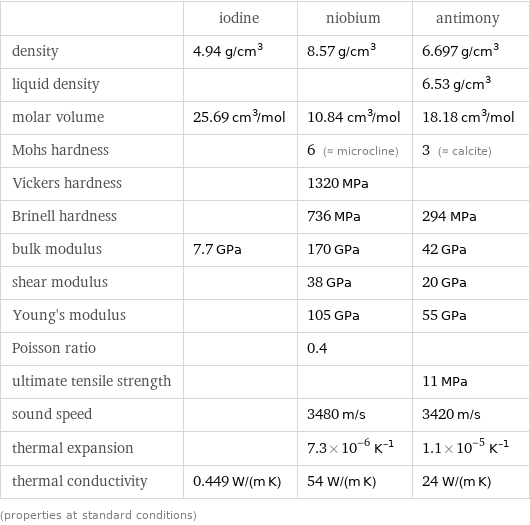
| iodine | niobium | antimony density | 4.94 g/cm^3 | 8.57 g/cm^3 | 6.697 g/cm^3 liquid density | | | 6.53 g/cm^3 molar volume | 25.69 cm^3/mol | 10.84 cm^3/mol | 18.18 cm^3/mol Mohs hardness | | 6 (≈ microcline) | 3 (≈ calcite) Vickers hardness | | 1320 MPa | Brinell hardness | | 736 MPa | 294 MPa bulk modulus | 7.7 GPa | 170 GPa | 42 GPa shear modulus | | 38 GPa | 20 GPa Young's modulus | | 105 GPa | 55 GPa Poisson ratio | | 0.4 | ultimate tensile strength | | | 11 MPa sound speed | | 3480 m/s | 3420 m/s thermal expansion | | 7.3×10^-6 K^(-1) | 1.1×10^-5 K^(-1) thermal conductivity | 0.449 W/(m K) | 54 W/(m K) | 24 W/(m K) (properties at standard conditions)
Electromagnetic properties
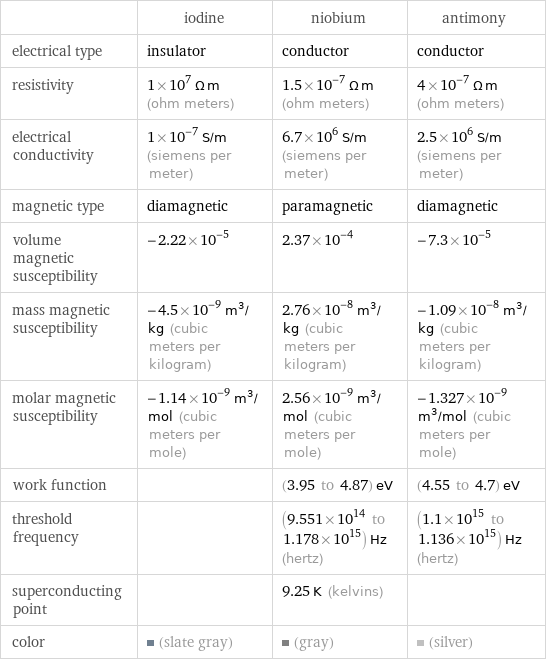
| iodine | niobium | antimony electrical type | insulator | conductor | conductor resistivity | 1×10^7 Ω m (ohm meters) | 1.5×10^-7 Ω m (ohm meters) | 4×10^-7 Ω m (ohm meters) electrical conductivity | 1×10^-7 S/m (siemens per meter) | 6.7×10^6 S/m (siemens per meter) | 2.5×10^6 S/m (siemens per meter) magnetic type | diamagnetic | paramagnetic | diamagnetic volume magnetic susceptibility | -2.22×10^-5 | 2.37×10^-4 | -7.3×10^-5 mass magnetic susceptibility | -4.5×10^-9 m^3/kg (cubic meters per kilogram) | 2.76×10^-8 m^3/kg (cubic meters per kilogram) | -1.09×10^-8 m^3/kg (cubic meters per kilogram) molar magnetic susceptibility | -1.14×10^-9 m^3/mol (cubic meters per mole) | 2.56×10^-9 m^3/mol (cubic meters per mole) | -1.327×10^-9 m^3/mol (cubic meters per mole) work function | | (3.95 to 4.87) eV | (4.55 to 4.7) eV threshold frequency | | (9.551×10^14 to 1.178×10^15) Hz (hertz) | (1.1×10^15 to 1.136×10^15) Hz (hertz) superconducting point | | 9.25 K (kelvins) | color | (slate gray) | (gray) | (silver)
Reactivity

| iodine | niobium | antimony valence | 7 | 5 | 5 electronegativity | 2.66 | 1.6 | 2.05 electron affinity | 295.2 kJ/mol (kilojoules per mole) | 86.1 kJ/mol (kilojoules per mole) | 103.2 kJ/mol (kilojoules per mole) first ionization energy | 1008.4 kJ/mol (kilojoules per mole) | 652.1 kJ/mol (kilojoules per mole) | 834 kJ/mol (kilojoules per mole) ionization energies | 1008.4 kJ/mol | 1845.9 kJ/mol | 3180 kJ/mol | 652.1 kJ/mol | 1380 kJ/mol | 2416 kJ/mol | 3700 kJ/mol | 4877 kJ/mol | 9847 kJ/mol | 12100 kJ/mol | 834 kJ/mol | 1594.9 kJ/mol | 2440 kJ/mol | 4260 kJ/mol | 5400 kJ/mol | 10400 kJ/mol
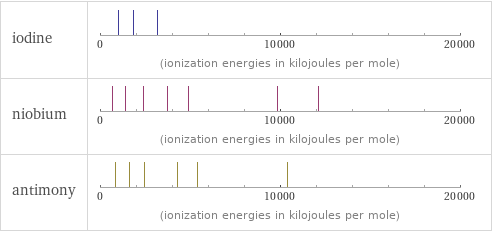
Reactivity
Atomic properties
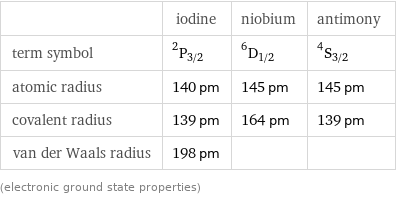
| iodine | niobium | antimony term symbol | ^2P_(3/2) | ^6D_(1/2) | ^4S_(3/2) atomic radius | 140 pm | 145 pm | 145 pm covalent radius | 139 pm | 164 pm | 139 pm van der Waals radius | 198 pm | | (electronic ground state properties)
Abundances
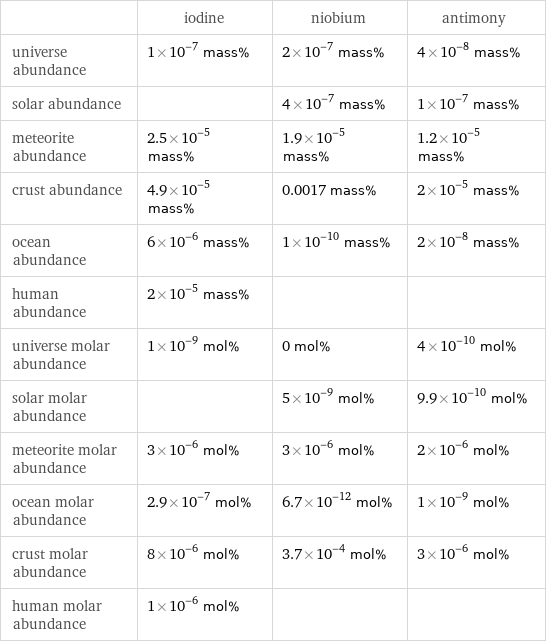
| iodine | niobium | antimony universe abundance | 1×10^-7 mass% | 2×10^-7 mass% | 4×10^-8 mass% solar abundance | | 4×10^-7 mass% | 1×10^-7 mass% meteorite abundance | 2.5×10^-5 mass% | 1.9×10^-5 mass% | 1.2×10^-5 mass% crust abundance | 4.9×10^-5 mass% | 0.0017 mass% | 2×10^-5 mass% ocean abundance | 6×10^-6 mass% | 1×10^-10 mass% | 2×10^-8 mass% human abundance | 2×10^-5 mass% | | universe molar abundance | 1×10^-9 mol% | 0 mol% | 4×10^-10 mol% solar molar abundance | | 5×10^-9 mol% | 9.9×10^-10 mol% meteorite molar abundance | 3×10^-6 mol% | 3×10^-6 mol% | 2×10^-6 mol% ocean molar abundance | 2.9×10^-7 mol% | 6.7×10^-12 mol% | 1×10^-9 mol% crust molar abundance | 8×10^-6 mol% | 3.7×10^-4 mol% | 3×10^-6 mol% human molar abundance | 1×10^-6 mol% | |